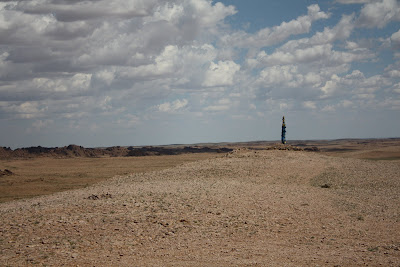Spending time with people who know how to traverse and live in the desert was fascinating. At first, the desert looked completely empty and barren, then, as I spent more time there, I began to see the network of tools, communication, and markers that people had established over hundreds of years of living in such a harsh climate. Some examples: ger orientation, blue cloths, and ovoo.
Gers are oriented with their door [and only opening in the vertical plane] facing south. This is mostly because the prevailing winds come from the north, though there seemed to be all kinds of subtle reasons for this orientation too [see upcoming post on this topic]. So, no matter where you are in the desert, find a ger, and you know where due south is. Of course, this orientation can easily be confirmed by the presence of the family solar panel, which is either over the entrance, or just to the side [and naturally, moves with the sun - more on this later too].
I started to notice bits of blue cloth stuck to the rocks and outcroppings, and it wasn't until we stopped at one that I learned what they signify: water! We clambered up the side of some rocks toward a blue cloth, and our guide moved some smaller rocks away from a perfectly round opening in the granite. We stuck our hands into it, up to the shoulder - and touched cool water. The rock formation was a giant cistern.
Ovoo [Mongolian for "heap"] are rock piles used in shamanistic worship of the sky or mountains, or Buddhist ceremonies; people add rocks to the piles when they pass by. Our drivers would often honk if we drove past one. Almost every family had a small ovoo, often on the highest point near their ger, that was used for family worship. They are landmarks, and can often be seen at great distances, because of the blue cloths that wrap them. They reminded me a bit of Celtic crosses that I saw all over Scotland, marking the "thin places" - places where the space between heaven and earth is thin.
These three things allow for all kinds of wayfinding and marking space/distance across the desert: practical [blue cloths], spiritual [ovoo], and terrestrial [ger orientation] - revealing a highly inhabited and mapped landscape, even without a soul in sight.
 |
| Gers facing south. Note solar panel! |
 |
| Chimeddorj shows us a water hole in the Gobi: I can feel water, hence my grin. What I really wanted was a straw. |
 |
| Blue cloth marking water hole, which is accessed under the two stones left of center. |
 |
| Ovoo on a bluff overlooking the Gobi. |
 |
| Ovoo; this one is about 8'-10' tall. |





No comments:
Post a Comment